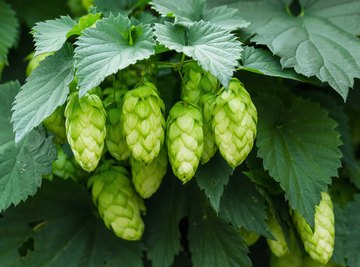
Botanists classify plants according to the Integrated Taxonomic Information System (ITIS), which proceeds through several subclassifications from kingdom to species. Marijuana, the flowering annual with fragrant and intoxicating buds, belongs to the genus Cannabis along with its closest relative, hemp. Cannabis is one of eight genera in the Cannabaceae family. Others include Humulus, better known as hops; Celtis, or hackberry; Trema, an evergreen tree; and Pteroceltis, which includes the blue sandalwood tree. Other relatives include Lozanella, a South American vine; Gironniera, a deciduous tree; and Aphananthe, an evergreen tree found in the tropics.
The Difference Between Marijuana and Hemp
Humans have grown cannabis for millennia, and – possibly because of cultivation practices – two strains have developed. Cannabis sativa is the variety known as marijuana. Although marijuana aficionados like to distinguish between sativa and indica varieties when discussing psychotropic effects, Cannabis indica is technically the subspecies known as hemp. It contains fewer cannabinoids than its medicinal cousin. In fact, in countries where it is legally grown, it must contain fewer than 0.3 percent THC, the most psychoactive of the cannabinoids. Marijuana, by contrast, contains anywhere from 5 to 30 percent THC. Hemp is primarily an industrial crop, prized for the strength of its fibers and its nutritional value.
Hops and Hackberries
No other member of the Cannabaceae family is as closely related to marijuana as hemp, but all are cousins. Humulus is one of the most notable. H. lupulus, the common hop, is a perennial vine that grows in USDA plant hardiness zones 4 through 8 and produces pine cone-like flowers used to flavor beer. The hackberry or nettle tree, C. occidentalis, is the largest species in the Cannabaceae family. It can reach heights of 40 to 100 feet and has elm-like leaves and pea-sized edible fruits that are eaten mostly by birds. Other species in the Celtis genus include C. laevigata, the Mississippi hackberry or sugarberry; and the European nettle tree, C. australis, which produces edible fruit and valuable lumber.
Edible Fruit and Leaves and Medicinal Seeds
Two other members of the Cannabaceae family grow primarily in Asia and Africa. Trema orientalis, one of the 15 species belonging to the Trema genus, can be an evergreen tree or a deciduous shrub, depending on the environment. Its flowers turn into edible black fruits, and its leaves are also edible. The blue sandalwood tree, which grows in China, is a species belonging to the Pteroceltis genus. The Chinese call this tree Qing Tan and use its wood for timber, its bark for paper, and oil extracted from its seeds as a medicine.
Cousins Twice Removed
Proceeding up the plant classification system, you find that the Cannabaceae family is part of the order Urticales. This order includes the following families: Cecropiaceae, or cecropia; Moraceae, or mulberry; Ulmaceae, or elm; and Urticaceae, or nettles. Although marijuana is related to these plants, the relationship is more distant than with those of its own family.
References
About the Author
Chris Deziel holds a Bachelor's degree in physics and a Master's degree in Humanities, He has taught science, math and English at the university level, both in his native Canada and in Japan. He began writing online in 2010, offering information in scientific, cultural and practical topics. His writing covers science, math and home improvement and design, as well as religion and the oriental healing arts.
